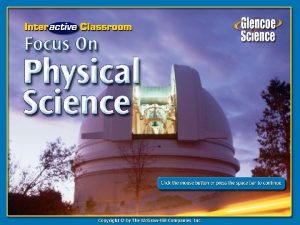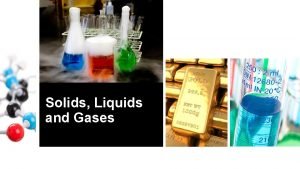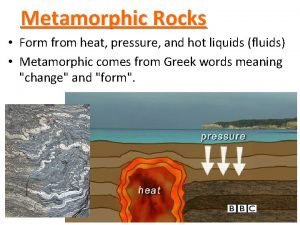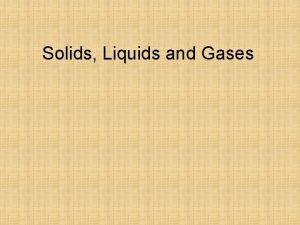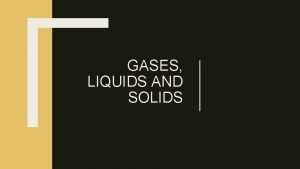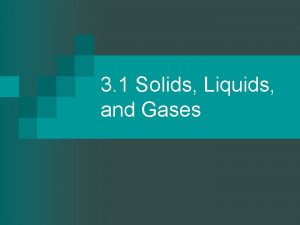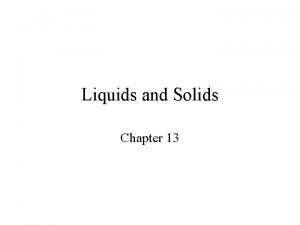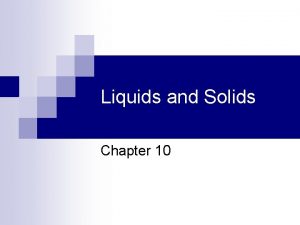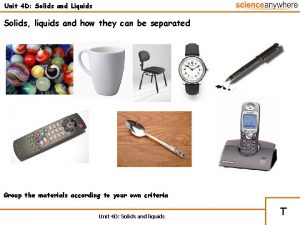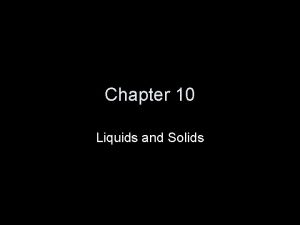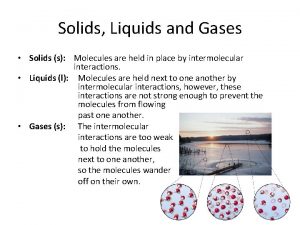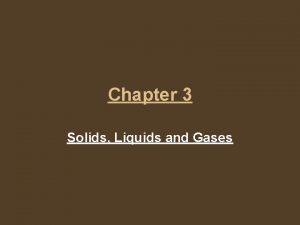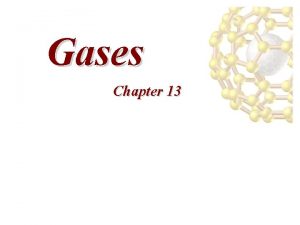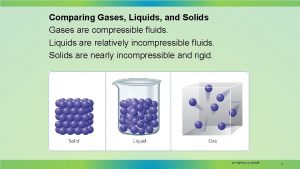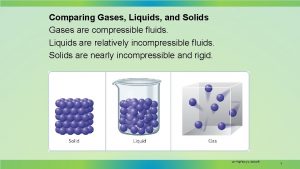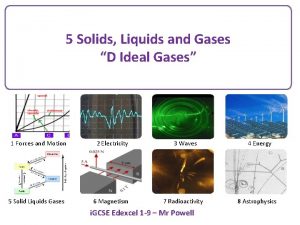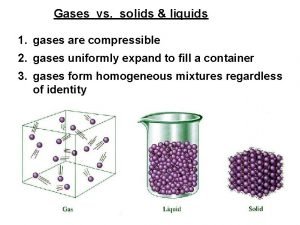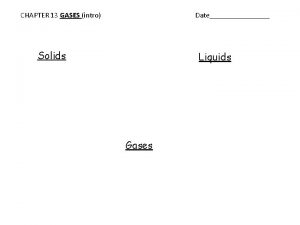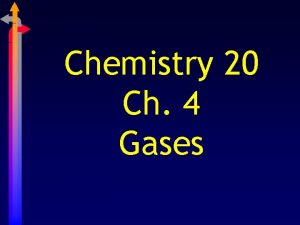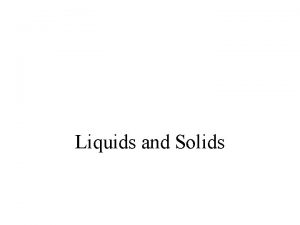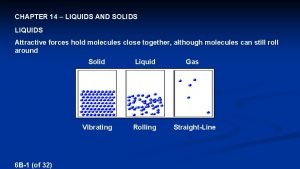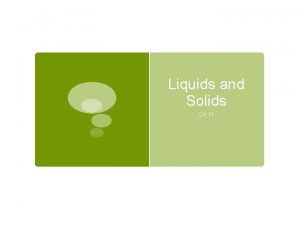Solids Liquids and Gases A 2 nd Grade

























- Slides: 25

Solids, Liquids, and Gases

A 2 nd Grade Poem Solids, Liquids, Gas Solids we bump into. Liquids we jump into. Solids can crash! Liquids will splash! Solids we can grab and grip, Not liquids – they drip. But air is a gas, Not solid like brass, Or liquids like juice, Air is all loose!!!

1. Liquids Definite volume Indefinite shape – takes the shape of the container. Flow, fluid, particles slip past one another. Low kinetic energy.

Adhesive Forces – attractive forces between particles of different substances. Capillary Action – water rising in very small diameter tubes – the adhesive forces between the water and glass are stronger than the cohesive forces in the water. Allows water to flow up the xylem of trees. Allows wax to flow up the wick! Gives the meniscus in glass containers.


Cohesive Forces – Attractive forces between the molecules in a liquid. Surface Tension – cohesive forces of liquid particles at the surface – the forces pull the particles closer together.


Evaporation – particles at the surface of a liquid gain enough energy to “escape” the liquid state and become a gas. When this happens, the liquid left behind decreases in temperature. Volatile Liquids evaporate quickly and easily.

2. Gases No definite shape or volume Fills the container Mostly empty space, can be compressed. Particles are moving with incredible kinetic energy (very fast). Gas particles move in random straight lines.

3. Plasma Gas like mixture of charged particles. Particles have extreme kinetic energy that when they collide they tear the electrons off creating positive and negative charged particles. When the electrons return to the nucleus, it gives back the energy in the form of light (electromagnetic radiation).

Plasma is the most common state of matter in the Universe - stars Lightning causes plasma. Also in neon signs, fluorescent bulbs, mercury/sodium vapor lamps, aurora borealis (northern), and aurora australis (southern).

4. Solids Definite shape and definite volume Vibrate in place, high cohesive forces, low kinetic energy. Crystalline Solids – particles form a geometric pattern called a crystal lattice. Table salt is an example. Amorphous Solids – particles do not form any patterns. They are sometimes called false solids. Wax and glass are examples.


Ice – Most solids “shrink” when frozen. Water expands when frozen because the molecules line -up for the hydrogen bonding. This is why ice floats in water – it is less dense.

Water density is the greatest at 4ºC.

Elasticity – ability of a solid to return to its original form when external forces are removed. Springs are elastic. Physical States. mov



5. Thermal Expansion Matter expands when heated. Particle motion increases and takes up more volume (space). Examples: Concrete roads/sidewalks crack when it is heated so they leave expansion joints. Bricks have holes. Bridges have joints Railroad tracks have gaps Welders will cool rivets so they will fill in the holes and then expand making a tight fit.



The amount of expansion depends on the type of material. Coefficient of Linear Expansion - Units are Thermal expansion is proportional to the increase in temperature. L = Li T Lf – Li = Li (Tf – Ti) Lf = Li + Li (Tf – Ti)

Page 317

Expansion can be in two directions (Area) or in three directions (Volume). V = Vi T - coefficient of volume expansion. = 3 A = 2 Ai T

Problems The coefficient of linear expansion of steel is 1 x 10 -5/°C. How much expansion should engineers anticipate in a 2, 000 -ft steel bridge if it undergoes a change in temperature from 0°C to 30°C?
 Thermal expansion and contraction examples
Thermal expansion and contraction examples Buoyancyability
Buoyancyability Venn diagram of matter
Venn diagram of matter Mass of solid liquid and gas
Mass of solid liquid and gas Examples of solids liquids and gases pictures
Examples of solids liquids and gases pictures Lesson outline lesson 1 solids liquids and gases answer key
Lesson outline lesson 1 solids liquids and gases answer key Chapter 14 solids liquids and gases worksheet answers
Chapter 14 solids liquids and gases worksheet answers Chapter 14 solids liquids and gases
Chapter 14 solids liquids and gases Red liquid element
Red liquid element How does sound travel through solids liquids and gases
How does sound travel through solids liquids and gases Matter and its composition
Matter and its composition Motion of particles in solids, liquids and gases
Motion of particles in solids, liquids and gases Gases are easily compressed because of the
Gases are easily compressed because of the Solid liquid gas examples
Solid liquid gas examples Adhesive force
Adhesive force Liquids and solids menu
Liquids and solids menu Kesler science.com
Kesler science.com Chapter 11 - states of matter: liquids and solids
Chapter 11 - states of matter: liquids and solids Molecular theory of gases and liquids
Molecular theory of gases and liquids Filter medium resistance formula
Filter medium resistance formula Nourishing element of stock
Nourishing element of stock A yolk and cream mixture that is used to thicken liquids
A yolk and cream mixture that is used to thicken liquids Conduction and breakdown in liquid dielectrics
Conduction and breakdown in liquid dielectrics Separating mixtures worksheet grade 8
Separating mixtures worksheet grade 8 Parent rock of quartzite
Parent rock of quartzite Grading system deped
Grading system deped















